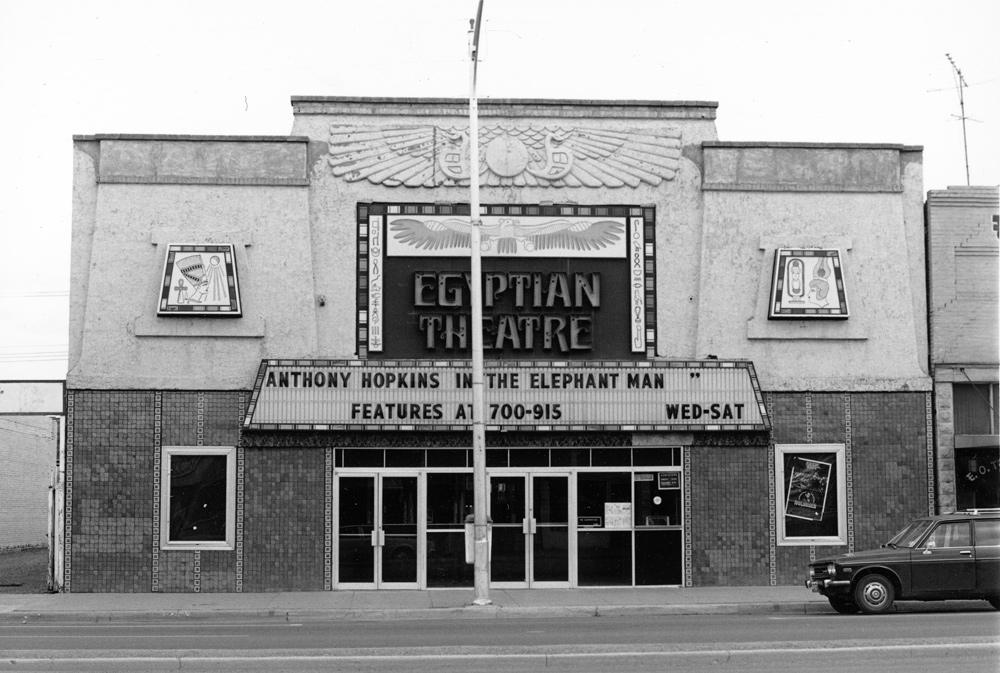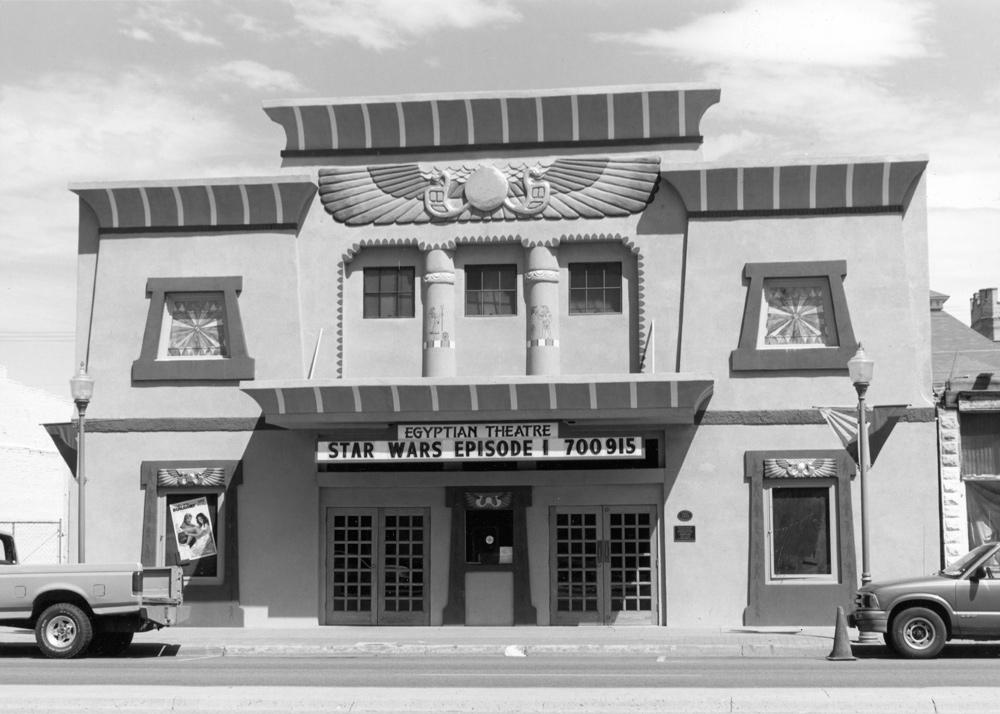Egyptian Theatre
Full Article
Built in 1928, the Egyptian Theatre in Delta was designed in the Egyptian Revival style by Denver architect Montana S. Fallis. The theater is perhaps best known as the site where the nationwide Depression-era “Bank Night” movie promotion began in 1933. The theater experienced a long period of decline in the late twentieth century but was restored in the 1990s and continues to show films today.
Early Years
The Denver-based Dickson & Ricketson chain of movie theaters decided to build a new theater in Delta in 1928. At the time, Delta was experiencing a boom driven by the opening of the Delta County Cannery and a Holly Sugar Company sugar mill, and the new theater on Main Street was planned to be the most modern and luxurious movie house in the thriving town. Architect Montana Fallis designed a two-story theater in the Egyptian Revival style, popular at the time because of the 1922 discovery of King Tutankhamen’s tomb. The $75,000 theater featured a $12,000 Robert Morgan organ, state-of-the-art mechanical systems, and 725 leather seats. Decorations by artist Joe Sheffler included Egyptian busts and murals lining the walls.
The theater’s grand opening was October 1, 1928, when it showed the Clara Bow comedy The Fleet’s In. When the Dickson & Ricketson chain was sold to Fox in 1929, the Egyptian became part of Fox Intermountain Theaters.
Bank Night
The Egyptian Theatre is where the popular Bank Night promotion began in 1933. The Great Depression hit the entertainment industry hard in the early 1930s. By the middle of 1933, about one-third of the movie theaters in the United States had closed. Those that stayed open often relied on promotions to attract business. Most promotions offered a merchandise giveaway, but in late 1932 Fox Intermountain district manager Charles Yaeger got the idea that a cash giveaway would be more successful.
In December 1932 Yaeger approached the Delta Chamber of Commerce with his plan, originally called “Gold Night.” People could get entry blanks with each twenty-five-cent purchase at local shops. One night a week, the Egyptian Theatre would hold a drawing, and the winner had to be in attendance with a paid admission ticket to claim the prize. (If the prize went unclaimed, it rolled over to the next week.) The promotion started on Thursday, March 2, 1933, with a $30 giveaway and continued for ten weeks with the same prize. On the eleventh Thursday, the theater offered a special $75 award.
The promotion proved wildly popular. Many people left after the prize drawing, but the theater earned money whether people stayed for the movie or not. Within two months the Egyptian Theatre was leading all Fox theaters in the region. Yaeger continued the promotion in Delta past the original eleven weeks. It soon spread to other Fox theaters, with some eventual tweaks to the purchase requirement to avoid antilottery laws.
By December 1933, Bank Night was becoming so popular that Charles Yaeger and his former boss, Frank Ricketson, trademarked the name “Bank Night” and started to license it to theaters across the country. Theaters paid five dollars a week to use the promotion. At first, Bank Night spread primarily to small-town and neighborhood theaters, but soon theaters in big cities embraced it. Yaeger and Ricketson raised the licensing fee to fifty dollars a week, and even though many theaters tried to avoid the fee by using other names, the pair still made tens of thousands of dollars in royalties. About 250 theaters in New York City alone used the plan. “‘Bank Night’ has blossomed into an American institution,” the Saturday Evening Post reported in 1937. “Each week more than 5000 theaters distribute almost $1,000,000 in prizes, as high as $3400 each.”
Bank Night vanished from popular culture almost as quickly as it had emerged. The promotion ran afoul of some states’ antilottery laws. Even where Bank Night was legal, its association with lotteries and gambling gradually gave it an unsavory reputation. Hollywood studios disliked Bank Night because of the gambling taint, which they felt it made their movies into cheap sideshow entertainments. Finally, and perhaps most important, the economy improved in the late 1930s. People had money to spend on entertainment again, rendering promotions such as Bank Night no longer necessary.
Decline and Restoration
As Delta’s population declined after 1950 and as newer theaters in Montrose and Grand Junction competed for business, the Egyptian Theatre struggled to attract customers. Its curtains and organ were removed; its upholstery frayed. By 1968 much of the theater’s original look and feel were gone. In the 1970s further renovations resulted in significant changes to the theater’s interior structure. The balcony was closed to customers, restrooms were relocated to the main floor, and a new snack bar and ticket booth were added. A neon sign and marquee replaced the projecting marquee on the front exterior.
In 1993 the theater was listed on the National Register of Historic Places. Over the next three years it was restored at a cost of $220,000, with help from a State Historical Fund grant. Much of the work involved stabilizing the theater’s foundation, walls, and roof. The interior renovations conducted by Conrad Schmitt Studios restored the theater’s bright Egyptian Revival colors and uncovered original artwork that had been painted or wallpapered over. The theater held a special screening to mark the completion of the project on October 1, 1997, the sixty-ninth anniversary of its opening. Guests dressed in 1920s outfits and enjoyed the 1927 silent film The King of Kings, complete with a Bank Night drawing during intermission.
Today the Egyptian Theatre continues to operate with a regular schedule of first-run movies.




